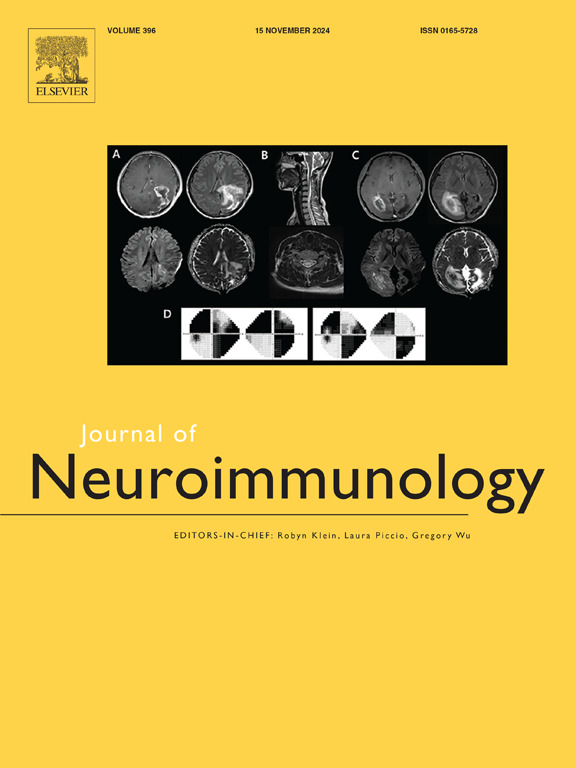Immune cells in dorsal root ganglia are associated with pruritus in a mouse model of allergic contact dermatitis and co-culture study
IF 2.9
4区 医学
Q3 IMMUNOLOGY
引用次数: 0
Abstract
The interaction between the neuroimmune system plays a crucial role in itch sensation, yet most research has focused on immune cells within the skin. Our study seeks to explore the presence and functions of immune cells within the dorsal root ganglia (DRG) in the context of allergic contact dermatitis (ACD). Immunofluorescence and histological staining techniques were employed to identify immune cells, including T-cells, basophils, mast cells, and dendritic cells (DCs), within the DRG of BALB/c mice sensitized and challenged with toluene diisocyanate (TDI). Our findings revealed an increase in mast cells and DCs within the DRG under ACD condition. Additionally, when DRG neurons were cultured with mast cells, a higher proportion of neurons exhibited responses to non-histaminergic pruritogens compared to neurons cultured alone. This suggests that mast cells may contribute to heightened sensitivity to non-histaminergic pruritogens. Furthermore, we conducted transcriptomic analysis of DCs within the DRG using RNA sequencing, followed by pathway enrichment analysis. Our analysis revealed that sorted DCs are implicated in immune responses, inflammation, and itch, with notable upregulation of Cathepsin S (Ctss) and sphingosine-1-phosphate (S1P) phosphatase 2 (Sgpp2). Subsequent functional experiments targeting CTSS in co-culture studies validated suppressed response to pruritogen and agonists of TRPA1 and TRPV1, indicating a potential role in peripheral sensitization. Additionally, the co-culture study indicated that the neuroimmune interaction between DCs and DRG neurons might involve S1P metabolism and S1P receptor signaling. In conclusion, targeting DCs and exploring the non-histaminergic functions of mast cells within the DRG, holds promise as novel targets for treating pruritus.

小鼠变应性接触性皮炎模型中背根神经节免疫细胞与瘙痒的关系及共培养研究
神经免疫系统之间的相互作用在瘙痒感觉中起着至关重要的作用,然而大多数研究都集中在皮肤内的免疫细胞上。本研究旨在探讨过敏性接触性皮炎(ACD)患者背根神经节(DRG)内免疫细胞的存在和功能。采用免疫荧光和组织学染色技术鉴定了甲苯二异氰酸酯(TDI)致敏和激发的BALB/c小鼠DRG内的免疫细胞,包括t细胞、嗜碱性细胞、肥大细胞和树突状细胞(dc)。我们的研究结果显示,在ACD条件下,DRG内肥大细胞和dc增加。此外,当DRG神经元与肥大细胞一起培养时,与单独培养的神经元相比,更高比例的神经元表现出对非组胺能性止痒剂的反应。这表明肥大细胞可能有助于提高对非组胺能性止痒剂的敏感性。此外,我们使用RNA测序对DRG内的dc进行转录组学分析,然后进行途径富集分析。我们的分析显示,分选的dc与免疫反应、炎症和瘙痒有关,组织蛋白酶S (Ctss)和鞘氨醇-1-磷酸(S1P)磷酸酶2 (Sgpp2)显著上调。随后在共培养研究中针对CTSS的功能实验证实了对瘙痒原和TRPA1和TRPV1激动剂的抑制反应,表明其可能在外周致敏中发挥作用。此外,共培养研究表明,dc和DRG神经元之间的神经免疫相互作用可能涉及S1P代谢和S1P受体信号传导。总之,靶向dc并探索DRG内肥大细胞的非组胺功能,有望成为治疗瘙痒的新靶点。
本文章由计算机程序翻译,如有差异,请以英文原文为准。
求助全文
约1分钟内获得全文
求助全文
来源期刊

Journal of neuroimmunology
医学-免疫学
CiteScore
6.10
自引率
3.00%
发文量
154
审稿时长
37 days
期刊介绍:
The Journal of Neuroimmunology affords a forum for the publication of works applying immunologic methodology to the furtherance of the neurological sciences. Studies on all branches of the neurosciences, particularly fundamental and applied neurobiology, neurology, neuropathology, neurochemistry, neurovirology, neuroendocrinology, neuromuscular research, neuropharmacology and psychology, which involve either immunologic methodology (e.g. immunocytochemistry) or fundamental immunology (e.g. antibody and lymphocyte assays), are considered for publication.
 求助内容:
求助内容: 应助结果提醒方式:
应助结果提醒方式:


